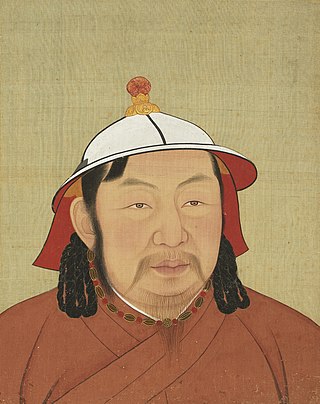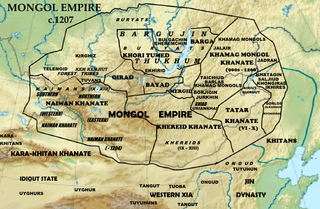
Khutughtu Khan, born Kuśala, also known by his temple name as the Emperor Mingzong of Yuan, was a son of Khayishan who seized the throne of the Yuan dynasty of China in 1329, but died in suspicious circumstances six months later. Apart from the Emperor of China, he is considered as the 13th Great Khan of the Mongol Empire, although it was only nominal due to the division of the empire.
Yesün Temür was a great-grandson of Kublai Khan and an emperor of the Yuan dynasty of China from 1323 to 1328. Apart from Emperor of China, he is regarded as the 10th Khagan of the Mongol Empire, although it was only nominal due to the division of the empire. In Chinese historiography, Yesün Temür, who was very fond of the traditional ways of the Mongols, is commonly known as the Taiding Emperor of Yuan based on his first era name. His name means "nine iron" in the Mongolian language.

Buyantu Khan, born Ayurbarwada, also known by his temple name as the Emperor Renzong of Yuan, was the fourth emperor of the Yuan dynasty of China. In addition to being the Emperor of China, he is regarded as the eighth Great Khan of the Mongol Empire, although it was only nominal due to the division of the empire. His regnal name "Buyantu Khan" means "blessed/good Khan" in the Mongolian language. His personal name "Ayurbarwada" was derived from a Sanskrit compound "Āyur-parvata", which means "the mountain of longevity", in contrast with Emperor Wuzong's name Qaišan.

Öljeyitü Khan, born Temür, also known by his temple name as the Emperor Chengzong of Yuan, was the second emperor of the Yuan dynasty of China, ruling from 10 May 1294 to 10 February 1307. Apart from being the Emperor of China, he is considered as the sixth Great Khan of the Mongol Empire, although it was only nominal due to the division of the empire. He was an able ruler of the Yuan dynasty, and his reign established the patterns of power for the next few decades.
Chungseon, born Wang Wŏn, later changed his name to Wang Chang, also known by his Mongolian name Ijir Bukhqa (益知禮普花), was the 26th ruler of the Goryeo dynasty of Korea. He reigned in 1298, and again from 1308 to 1313.

The Khongirad was one of the major divisions of the Mongol tribes. Their homeland was located in the vicinity of Lake Hulun in Inner Mongolia and Khalkha River in Mongolia, where they maintained close ties with the ruling dynasties of northern China. Because the various Hongirad clans never united under a single leader, the tribe never rose to great military glory. Their greatest fame comes from being the primary consort clan of the ruling house of Genghis Khan's Mongol empire. Genghis Khan's mother (Hoelun), great grandmother, and first wife were all Khongirads, as were many subsequent Mongol Empress and princesses.
Bayan of the Baarin, or Boyan was an ethnic Mongol general of the Yuan dynasty of China. He was known to Marco Polo as "Bayan Hundred Eyes". He commanded the army of Kublai Khan against the Southern Song dynasty, ushering in the Southern Song collapse and the conquest of southern China by the Yuan dynasty.
Zhenjin, also rendered as Jingim, Chinkim, or Chingkim, was a crown prince of the Yuan dynasty of China. He was a son of Kublai Khan and grandson of Tolui.

Kublai Khan, also known by his temple name as the Emperor Shizu of Yuan and his regnal name Setsen Khan, was the founder and first emperor of the Mongol-led Yuan dynasty of China. He proclaimed the dynastic name "Great Yuan" in 1271, and ruled Yuan China until his death in 1294.
Yingchang was one of the important cities in the Yuan dynasty. It was situated on Lake Taal Nor in modern Heshigten Banner, Inner Mongolia, China.
Nambui was a Khongirad empress consort of the Yuan dynasty. She was married to Kublai Khan after the death of his first wife Chabi.

Sugabala or Sügebala was an empress consort of the Yuan dynasty, married to Gegeen Khan.
Princess Supreme Jeguk, also known as Queen Jangmok and Queen Mother Inmyeong was a Yuan imperial princess as the daughter of Kublai Khan and Chabi khatun. She became the first Goryeo queen consort from Yuan. She was the primary wife of Chungnyeol of Goryeo and the mother of his successor, Chungseon of Goryeo. Her personal name was Borjigin Qutlugh Kelmysh.
Toghon was the ninth son of Kublai Khan, founder of the Yuan dynasty. He was a commander of the Mongol forces in the Mongol invasions of Vietnam.
Manggala was a prince of the Mongol-led Chinese Yuan dynasty. He was a son of the Yuan founding emperor Kublai Khan.

Shirindari was Khatun of Mongols from 1294 to 1305 as principal consort of Temür Khan.
Darmabala was an imperial prince of the Yuan dynasty. He was a grandson of Kublai Khan and son of his Crown Prince Zhenjin. He was an ancestor of subsequent Yuan monarchs who came after Temür Khan and the Goryeo kings of Korea after King Gongmin.
The fashion in the Yuan dynasty of Mongol (1271–1368) showed cultural diversity with the coexistence of various ethnic clothing, such as Mongol clothing, Han clothing and Korean clothing. The Mongol dress was the clothing of elite for both genders. Mongol attire worn in the 13th-14th century was different from the Han clothing from the Tang and Song dynasties. The Yuan dynasty court clothing also allowed the mixed of Mongol and Han style, and the official dress code of the Yuan dynasty also became a mixture of Han and Mongol clothing styles. After the founding of the Yuan dynasty, the Mongols strongly influenced the lifestyle and customs of the Han people.
Alaqush Tegin Quri or Alaqush Digit Quri was a tribal leader of Onguds and a contemporary of Genghis Khan.







